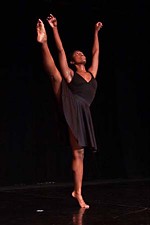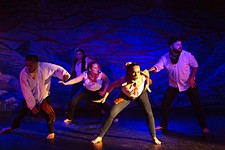Big Range Austin
Whatever comes out, that's what it is
By Jonelle Seitz, Fri., June 12, 2009
Hence rule No. 1 for audience members: Don't go expecting a "performance." "Performing" isn't what the movers and musician-director Adam Sultan are interested in here. There are no calculated effects, so there's little to support judgment. "The audience is just there to witness it," says Akita. "We don't know what's going to happen. Whatever comes out, that's what it is."
So how do you rehearse – and perhaps that's too strong a word – for a piece like this? Truth be told, Sultan, in his first go at directing a movement improv session, isn't quite sure himself. (He played music for the improv program at last year's Big Range, but there was no director.) There are a couple ways of going about improvisational movement, and at the time of this writing, Sultan had more experimentation to do before committing to one or the other. There might be points in the piece where everyone will reach prescribed goals at once or the score might be completely open, with each individual having his or her own set of rules to work with.
One thing is for certain: Since Sultan doesn't have much of a dance background, he's not using dance vocabulary to tell the dancers – whom he refers to as "players" – what he wants. "I'm not regarding it as a dance," he says. "It's more about expression of the body than it is about recognizing it as modern dance." Rather, it's about relationships, about being aware of and responding to changes in the environment, the space, the presence and movement of others, the pull of relationships, and one's own motives. Sultan explains, "A lot of what we're doing has to do with listening in space – not just listening with our ears – and hopefully challenging what we're used to."
To push the dancers beyond familiar movement, Sultan gives each a specific objective or limitation, such as "don't use your left leg." He explains: "Conventionally, you might think, 'Oh, I'm screwed.' And it's not an object of 'Guess what's wrong with me?' or, 'Oh, they don't have a left leg.' It's more like, 'OK, how can I be in the space and just know that I can't use that?' And the struggle is what becomes the interesting point." But in order to let the "limitations" unlock mental and physical doors to previously unexplored ways of moving, "it's important to just regard everything as what's happening, your awareness of how you're feeling, and what the struggle is, without trying to solve it."
Rehearsals begin slowly, with simple gestures, to allow the movers to tune into their impulses. "Sometimes I think, 'Why am I moving in a certain way, in a certain style?'" says Akita. "Sometimes it doesn't really feel sincere, and I think that's what I'm trying to avoid. I have to fully commit to it, to whatever I'm doing." Akita and Sultan, who, as the sole musician in the piece, aims to be "just another player," agree that choice is key: making choices, owning them – even if what happens wasn't what you thought would or intended to happen – and seeing where they take you.
With two sessions, there's no doubt that those choices will make each look and sound different, but will they be fundamentally different? The answer to that question requires defining the result – not an easy task. After each rehearsal session, Sultan asks the movers how they felt about it. "There's no way I can tell," says Akita.
Big Range Austin, Program C, runs Thursday and Friday, June 11–12, 9:30pm, at AustinVentures StudioTheater, 501 W. Third. For more information, visit www.bigrangeaustin.org.










